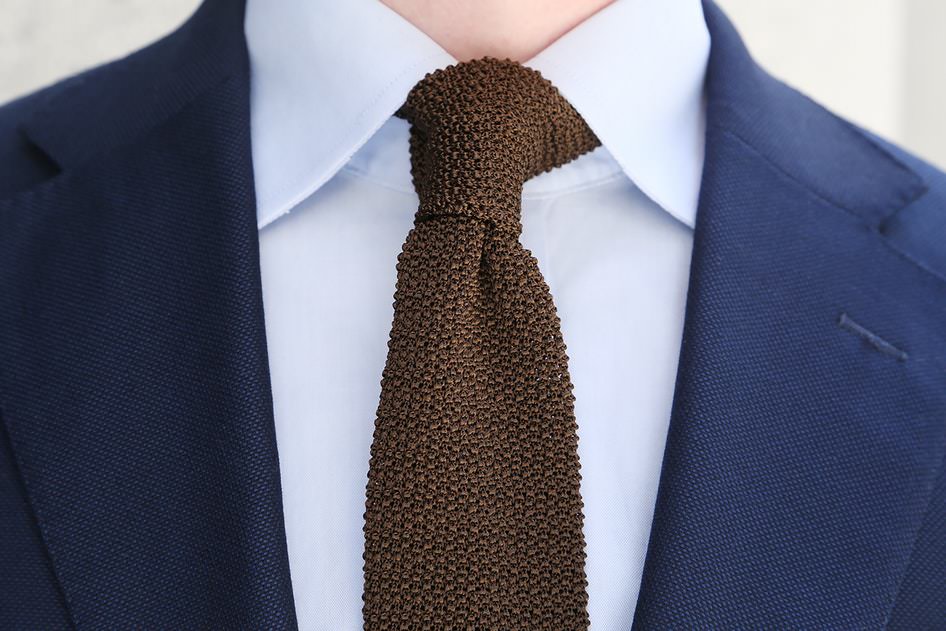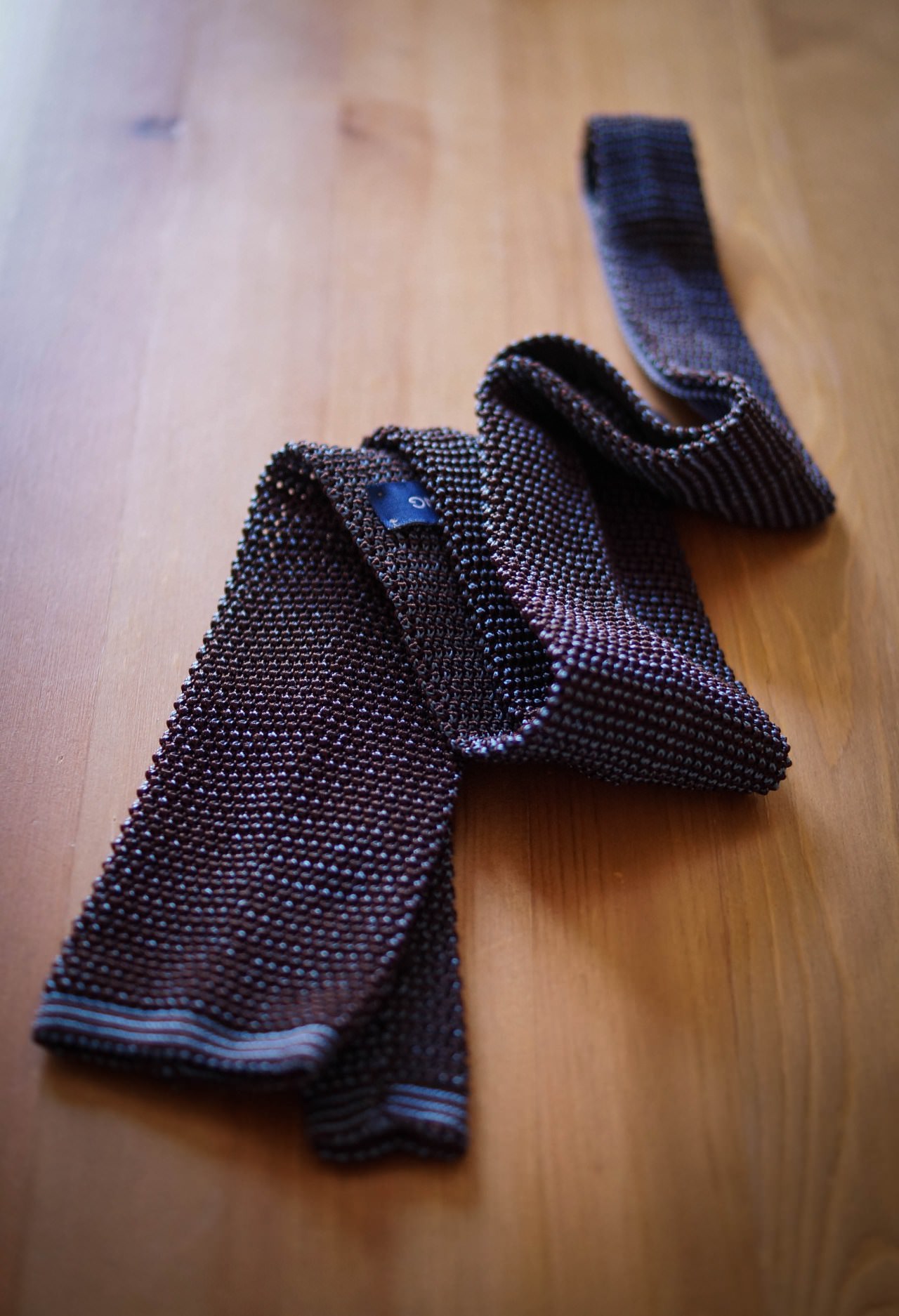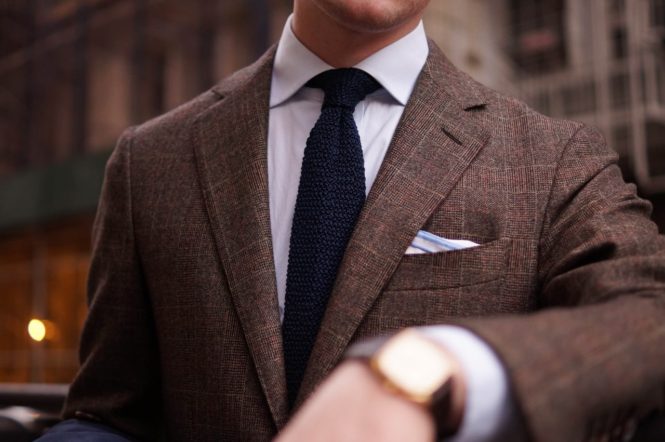The role of the necktie in modern dress has waned significantly, even with the resurgence of classic menswear in the past ten years. Even so, it’s worth having a solid understanding of different types of ties so that when you do choose to wear one, you know that you’re doing so to your full potential. I find the knit tie to be one of the most useful tie variants in this post-tie world, and figured it would be worth diving into a bit more detail on why I like them and where I like to purchase from.
About Knit Ties
Knit ties occupy a special place in the spectrum of neck decoration – they’re considered a “casual tie,” which is a bit of an oxymoron in today’s world, since men are probably more likely to wear a suit without any tie at all than dress it down with a “casual tie.” Because occasions that require professional attire are becoming less common, though, it’s worth having a knit tie in your arsenal so that you can get buttoned up without looking like you’re going to a wedding, funeral, or congressional hearing. The texture and floppy structure of knit ties give them a bit of a “sure, I’m wearing a tie but it’s not a big deal”-type vibe.
While both knit ties and “traditional” ties are worn around your neck and often made of silk, they’re quite different things when you get down to it. Traditional ties are made by cutting and sewing together pieces of woven fabric, and knit ties are knit (go figure) into a tube shape out of thick yarn (usually silk). In other words, they’re more like a tube sock than a regular tie in a lot of ways. They also typically have a square end, although some are available with a point. Unlike traditional ties, knit ties require specialized equipment so only a few factories make them. That’s one of the reasons that many of the products on this list look similar – they’re all coming from just a handful of places.
Materials, Patterns, and Colors: Silk is the most common material for knit ties, with wool, cashmere, and cotton also making appearances for more seasonal styles. They are often solid-colored, although the construction lends itself to horizontal stripes as well. Dots are another great pattern for knits – the really good ones will have the dots hand woven in, which is a beautiful thing. Black knit ties are often considered “essential” and the “classic” choice, although feel free to take that with a grain of salt. It’s true that the literary (and imaginary) James Bond wore one, but wear whatever suits your lifestyle. My favorites are navy, dark brown, and bottle green.
Width: due to the fact that there is no taper on a knit tie, it’s common for them to be thinner than a normal tie. This makes them a good option for guys that want a skinnier tie without it looking like they’re wearing a skinny tie, if that makes sense. Most knit ties are in between 2.25” – 3” (whereas standard ties tend to be 3 – 3.5”, and anything under 3” is quite skinny). I prefer knit ties around 2.75”, but do whatever suits you.
Texture: any good knit tie will have some interesting texture (one of the reasons it’s considered a good casual tie), but it can manifest itself in different ways. The two main categories are often referred to as soft and crunchy. The soft ones will often have a smooth, floppy hand, whereas the crunchy ones are known for their dense, stiffer texture and, believe it or not, the squeaky sound they sometimes make when you pinch/rub them (thus their other name, “cri de la soie” or “cry of the silk”). The crunchy ones tend to have a bit more of an enthusiast following, but both are good.
How to wear it: First, understand that using a four-in-hand knot is probably the only way to go with a knit tie. Their construction makes the knot quite bulky, so any larger knot will result in a huge lump on your collar. As for what to wear them with, knit ties generally pair best with tailored clothing that’s less formal than a traditional suit. Things like a navy blazer with chinos, flannel trousers with tweed jackets, cotton/linen suits, and so forth are a great backdrop for knits. I don’t wear ties that often anymore, but when I do I’m usually reaching for one of these.

Where to Buy Knit Ties
Under $50:
-
The Tie Bar: No list of entry-level tie companies is complete without mentioning the Tie Bar. Personally, I found their regular ties to be a better value than their knits (which are a bit flat), but for $25 it’s a fine buy. I generally think of the Tie Bar as the same quality you’d find at your average mall-brand retailers, but you don’t have to wait for a sale.
-
Land’s End: This is my favorite inexpensive knit tie. Made in Italy, 100% silk, classic colors and proportions. Somewhat crunchy texture. The price of these has gone up over the years, but they shouldn’t be too hard to snag at 30-40% off (like right now). At prices like that, I think they’re the best buy for under $50.
-
Ebay/thrifting: Ties are a great candidate for secondhand shopping because they’re mostly one-size-fits-all and are easy to find. Many of my ties were bought from ebay and other secondhand markets. Just make sure that there aren’t any stains from the original owner’s lunch on them.
$50-100
-
The Knottery: Their “premium” knit ties are made in Germany by the same manufacturer that produces knit ties for Drake’s (see below). The result is a super crunchy knit tie at an excellent price. Probably the best value on this list in my opinion. The downside is that Jay at the Knottery is busy with a few other projects, so who knows how often they’ll be restocked (if at all) once they’re gone.
-
Chipp: A classic selection of knit ties from a classic-styled retailer. Chipp generally has pretty good prices, so at around $50 you’re getting a solid product.
-
Kent Wang: ties are one of the cornerstones for this e-haberdasher. He has a variety of made-in-Italy knit ties, but my favorite are the bicolor knits. These use two different colors of yarn to create a beautiful iridescent effect. Hard to explain but looks great in person.
-
Sozzi: a great example of the soft knit construction. The most famous Sozzi ties are the zig-zag knits, which can be found at a variety of retailers.
-
Shibumi: This accessory-focused retailer always has good stock of a variety of knit tie styles. They also generally have some zig-zag knits made by Sozzi.
-
Berg & Berg: Another retailer of soft, Italian-made knit ties.
-
Brooks Brothers: the classic men’s haberdasher will have a rotating selection of ties every season. Many are made in Italy and some elsewhere depending on the collection, so keep an eye out. Generally a good buy when on sale.
-
Stoffa: Agyesh Madan is a pro when it comes to textiles, and his whole collection shows off this knowledge. The weaving patterns on his knit ties are unlike many others you’ll see on the market, making them a great choice if you want something made well but also a bit more unique. Made in Italy.
Over $100
-
Drake’s: This UK-based menswear darling has become the gold standard for ties, even though their knit ties are made in Germany and not in-house like their other ones. As mentioned previously, they are super crunchy-feeling and have a dry hand. Much more expensive than the same product at the Knottery but more readily available and in a wider array of styles and colors.
-
Ralph Lauren Purple Label: Polo Ralph Lauren generally has a few styles around $100, but the truly luxurious RLPL is where I’d go for neckwear. I have one of these ties from about ten years ago and it’s one of my favorite pieces of clothing. I get compliments on it all the time. It’s not that crunchy, but it’s dense and soft and has tons of texture.
-
Charvet: the famed French shirtmaker is also known for exceptional neckwear. With that said, I’ve never handled their stuff so while I have no doubt that it’s great, I don’t have much to add.
-
Rubinacci: this Italian luxury powerhouse is known for their accessories, and knitter ties are no exception. A wide selection of patterns, weaves, and colors.
All told, knit ties are an ideal choice for “casual” ties, if such a thing exists anymore. Land’s End makes the best inexpensive ones (wait for a sale), the Knottery makes excellent mid-priced ones, and Drakes and RLPL are great luxury buys. Don’t forget that ties are a great thing to buy secondhand. Silk is the classic material for knit ties, and they’re easiest to wear in dark colors like black, navy, and dark brown, in widths around 2.5-2.75”.
Note: Here’s an album of products I mention in this post. I originally wrote this article for Reddit’s Male Fashion Advice community. Since the information may be useful to this audience as well, I’ve decided to post it here.

